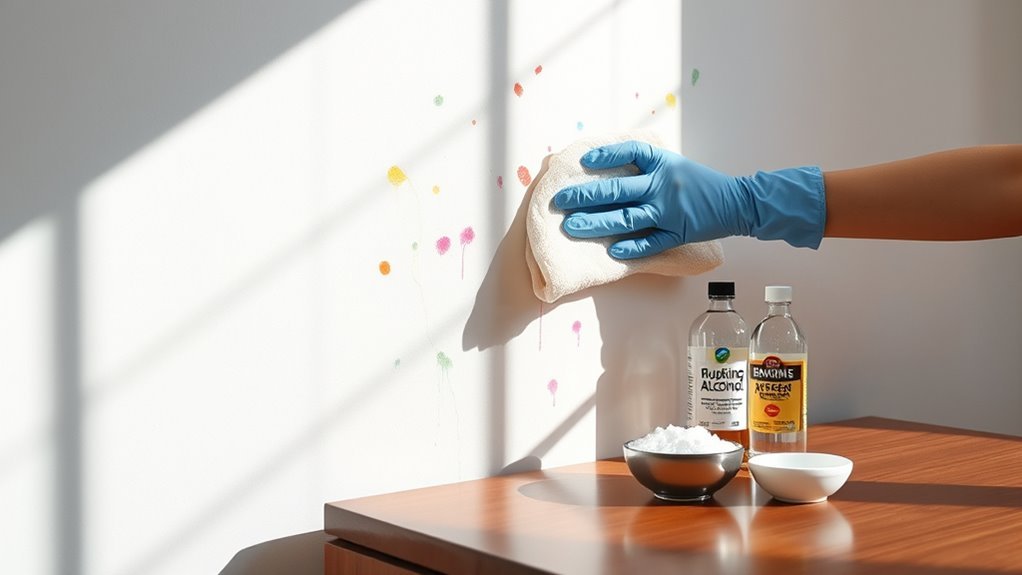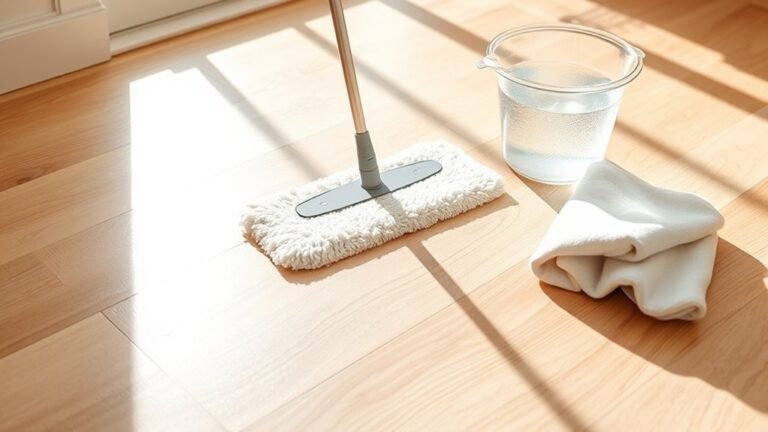How to Clean Marker Stains From Walls
To clean marker stains from your walls, first figure out if it’s a dry erase or permanent marker, as this affects the method you’ll need. Gather supplies like mild soap, isopropyl alcohol, or baking soda paste. Test any cleaner on a small spot to avoid damage, especially on painted or wallpapered surfaces. Gently apply your chosen solution, avoiding harsh scrubbing. If stains persist or walls get damaged, consider expert help. Keep going, and you’ll discover tailored tips for different wall types and prevention!
Identifying the Type of Marker Stain

Before you can effectively clean marker stains from your walls, you need to identify the type of marker used. Permanent markers and dry erase markers behave very differently on surfaces. Permanent markers soak into the paint, making them tougher to remove, while dry erase markers sit more on the surface, often easier to wipe away. You’ll want to test a small area first to see if the stain smudges or stays put. Recognizing whether the stain is from a permanent marker or a dry erase one frees you to choose the right cleaning method without damaging your walls. Knowing this difference empowers you to act confidently, so you can reclaim your space and enjoy the freedom of a clean, fresh wall once again.
Preparing Your Cleaning Supplies
Once you’ve figured out the type of marker stain you’re dealing with, gathering the right cleaning supplies will make the job easier and more effective. You want to choose cleaning solutions that suit the stain’s nature and protect your walls. Along with these, having essential tools ready means you can tackle the stain freely and efficiently without interruptions.
| Essential Tools | Cleaning Solutions |
|---|---|
| Soft cloth or sponge | Isopropyl alcohol |
| Cotton swabs | Mild dish soap |
| Plastic scraper | Baking soda paste |
Keep these supplies handy so you can approach the cleaning process with confidence and freedom. Having everything prepared guarantees you’ll restore your walls without hassle or damage.
Using Household Items to Remove Marker Stains

Three common household items—mild dish soap, baking soda paste, and isopropyl alcohol—can effectively remove marker stains from your walls. Start with a gentle approach: mix mild dish soap with water to wipe away fresh marker marks. If stains persist, create a baking soda paste by blending baking soda with a little water; apply it gently, then rinse clean. For tougher stains, dab rubbing alcohol (isopropyl alcohol) onto a cloth and softly rub the affected area. You can also try a vinegar solution, mixing equal parts vinegar and water, which helps lift stains without harsh chemicals. Adding a few drops of essential oils to your cleaning mix not only refreshes the room but can boost cleaning power. These household items give you the freedom to clean without buying specialized products.
Techniques for Different Wall Surfaces
When tackling marker stains, the approach changes depending on your wall surface. You’ll need gentle methods for painted walls, careful techniques for wallpaper, and specific care for wood surfaces to avoid damage. Let’s explore the best ways to clean each type effectively.
Cleaning Painted Walls
Although cleaning marker stains from painted walls can be tricky, knowing the type of paint finish you’re dealing with makes a big difference in choosing the right technique. If your wall has a glossy or semi-gloss paint finish, you have more freedom to use stronger cleaners like rubbing alcohol or a magic eraser without damaging the surface. For matte or flat finishes, be gentler—opt for diluted dish soap and water to avoid removing paint or altering the wall texture. Always test a small, hidden area first. The wall texture also plays a role; smooth walls are easier to clean, while textured walls may trap marker ink in crevices, requiring a soft brush to reach all spots. With the right approach, you can reclaim your walls without sacrificing their finish or texture.
Removing Stains From Wallpaper
Cleaning marker stains on wallpaper requires a different approach than on painted walls because of its delicate surface and varied materials. Since wallpaper types range from vinyl to fabric, stain removal methods must be chosen carefully to avoid damage. Here’s how you can tackle it:
- Identify your wallpaper type to pick the safest cleaner.
- Test a small, hidden area first to check for colorfastness.
- Use a gentle solution like diluted dish soap or a vinegar-water mix applied with a soft cloth.
- Avoid harsh scrubbing; blot gently to lift the stain without tearing or discoloring.
Care for Wood Surfaces
Since wood surfaces can be sensitive to moisture and harsh chemicals, you’ll need to choose your cleaning methods carefully to avoid damage. Start by gently wiping the marker stain with a soft cloth dampened with a mixture of mild soap and water. Avoid soaking the wood to maintain proper wood care and prevent warping. If the stain persists, try using a small amount of rubbing alcohol on a cotton ball, testing it first in an inconspicuous spot. Always follow up by drying the area immediately to preserve surface protection and prevent moisture absorption. Regularly applying a quality wood conditioner or polish can also help maintain the integrity of your wood surfaces, giving you freedom from worry about stains and keeping your walls looking fresh and protected.
Preventing Marker Stains in the Future
To keep your walls looking fresh, you’ll want to take steps that minimize the chance of marker stains in the first place. Preventive measures are key, and child education plays a big role in this. Teaching kids about where markers belong can save you lots of hassle.
Here are four simple tips:
- Set clear boundaries by designating specific areas for drawing.
- Provide plenty of paper or coloring books to channel creativity.
- Use washable markers to reduce permanent damage.
- Store markers out of reach when not in use.
When to Call a Professional Cleaner

If the marker stain won’t budge after your best efforts or the wall’s paint starts to peel, it’s time to call a professional cleaner. You’ll want to choose someone experienced with delicate surfaces to avoid further damage. Knowing when to seek expert help can save you time and protect your walls.
Signs for Expert Help
When marker stains on your walls won’t budge despite your best efforts, it might be time to call in a professional cleaner. Professionals bring specialized knowledge and professional tools that can handle tough stains without damaging your walls. If you’ve been increasing your cleaning frequency but still see no improvement, it’s a clear sign you need expert help. Here are four signs to watch for:
- Stains persist after multiple cleaning attempts.
- You notice wall damage or discoloration from DIY cleaning.
- Marker stains cover a large area, making home cleaning impractical.
- You want to preserve your wall’s finish and avoid costly repairs.
Knowing when to step back lets you reclaim your freedom from stubborn stains without stress.
Choosing the Right Cleaner
Knowing when to call a professional cleaner is only part of the equation; choosing the right one can make all the difference in restoring your walls. Different marker types require specific cleaner options, and pros know exactly which products will work without damaging your paint or wallpaper. You want someone experienced with a range of stains—from washable to permanent markers—so they can tailor their approach. Don’t settle for the first service you find; ask about their expertise with your particular marker type and what cleaner options they use. This way, you maintain control over the outcome while freeing yourself from the hassle. Picking the right professional guarantees your walls get the care they deserve, helping you reclaim your space with confidence and ease.
Frequently Asked Questions
Can Marker Stains Damage the Paint on My Walls Permanently?
You might worry if marker stains can permanently damage your walls, and it really depends on the marker types and your paint durability. Permanent markers tend to penetrate deeper, making stains tougher to remove, while washable markers usually don’t cause lasting harm. If your paint is durable and well-sealed, you’ve got a better chance of cleaning without damage. So, knowing your markers and paint helps you keep your walls looking free and fresh.
Are There Specific Markers That Are Easier to Clean Than Others?
Oh sure, wouldn’t it be great if all markers were easy to clean? Unfortunately, permanent markers love to stick around, while washable ones practically beg you to wipe them off. When you choose marker types, remember washable markers give you more freedom to express without fear of forever stains. So, if you want to avoid a wall that screams “permanent,” pick washable markers and save yourself the hassle of scrubbing later.
How Long Should I Wait Before Cleaning a Fresh Marker Stain?
You don’t have to wait long before tackling fresh stains—act quickly for the best results! The sooner you start using effective cleaning techniques, the easier it’ll be to lift the marker without damaging the surface. Waiting too long lets the stain set, making it stubborn. So, grab your cleaning supplies and get moving right away; freedom from those pesky marks is just a quick wipe away!
Is It Safe to Use Bleach on Marker Stains Indoors?
You probably want to avoid using bleach indoors because it can be harsh and release strong fumes, which isn’t great for your freedom to breathe easy. Instead, consider bleach alternatives like vinegar, baking soda, or rubbing alcohol—they’re safer and effective. For indoor cleaning tips, always test on a small spot first and guarantee good ventilation. That way, you keep your space fresh without risking damage or health issues.
Can Marker Stains Affect Indoor Air Quality or Health?
Marker stains can release indoor pollutants, especially if they’re from permanent markers containing solvents. These chemicals might cause health concerns like headaches, dizziness, or respiratory irritation, particularly in poorly ventilated spaces. You don’t have to live with that risk—making sure to clean marker stains promptly and keep your space well-ventilated helps protect your freedom to breathe easy and stay healthy indoors.






